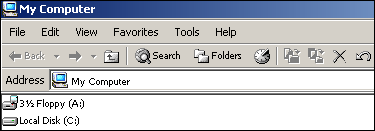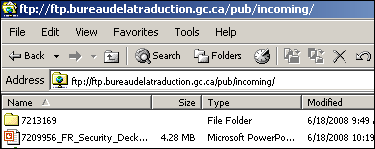Avertissement
La version française de cet article, qui s’intitule Tendances – Le supplice a assez duré (Libérez les données prises en otage!), figure dans l’outil Chroniques de langue.
André Guyon
(Language Update, Volume 5, Number 2, 2008, page 29)
In Canada, there are a handful of products on the market to help us manage our translations and terminology. At first, we thought we were sitting pretty and could pick the tool we wanted to use! We examined them, attended trade shows and wanted to narrow the choice down to one or two of these applications.
We soon came to the realization that these same tools were also being sold to our clients. Some clients required us to have the same software as they did, otherwise they wouldn’t do business with us. A Canadian translator or terminologist may need three, four or even five different tools to deal with as many clients. It’s certainly not easy being a language pro!
These tools are in addition to the well-stocked toolbox that we already have, and we need to spend long hours to become proficient at them, much as we had to do with our reference works. Ok, so it’s the price we have to pay.
However, when we see that the investment we make in a software application is all for naught, we revolt —and rebel— with good reason.
I’m not sure whether there is a more appropriate word than "absurd" to describe having to invest thousands of dollars and dozens of hours in something without seeing a significant increase in revenueFootnote 1, only to find out later that the data stored using software A could not be easily imported into software B, and so on.
Obviously, a common exchange format is required. Such an exchange standard would make it possible to transfer valuable data that was recorded with love and patience from one program to another. I will provide more details below.
The translation memory exchange standard (TMX) has garnered some support from software designers, while the TermBase exchange format (TBX) has seen little in the way of support. However, persons who represent software designers actively participate in working groups that develop these standards.
In fact, most software designers are more than willing to comply with the exchange standards if there is a demand for them from their clients and usersFootnote 2.
With TMX 2.0, a TMX file can be used to create an exact reproduction of the files that make up the translation memory. Despite vendors’ claims, their products are sometimes far from being truly compliant with the most recent TMX standard.
You can easily see for yourself:
Take the source language version and the target language version of a text containing tables (preferably in Word or HTML format). Ask designers to build a small memory, and then ask them to reconstitute the source text. You can draw your own conclusions. That said, the glass is half full, not half empty.
Like TMX, TBX is a LISAFootnote 3 standard, but it also is a draft ISO standard (30042). TBX is a terminology interchange format that is very comprehensive and quite complex. If all terminology management software designers were to adopt it tomorrow, our data exchange issues would virtually be a thing of the past.
Unfortunately, most software designers have not yet made the transition because everyone is reluctant to do so. The adoption of the draft ISO standard will encourage large organizations to adopt the TBX data exchange format. More and more products with outputs in TBX format are coming to market.
Once the majority of designers of translation software solutions adopt these standards, the data and language world will no longer be held hostage.
- Developers will be able to export to this single exchange format instead of trying to be compatible with the format used by the market leaders.
- They will be able to focus their energies on making products that are more robust and on improving interfaces.
- They will reap the same benefits when importing data.
- We language professionals will be free to choose our work tools instead of having to work with those chosen by our clients.
- We can thus choose our tools based on our perception of product user-friendliness and robustness.
- We can leave programs equipped with more management features and second-rate word-processing functions to others.
- Clients will be free to choose language professionals based on their abilities rather than their tools.
- Clients can choose a strong management tool without having to impose it on language professionals and concern themselves with compatibility.
- Clients will have access to a larger pool of language professionals.
- Organizations that want to exchange data will be free to do so even if they do not have the same software.
Practice
You do not intend to buy an FTP software application, but would like to be able to occasionally send data to an FTP site. A little intimidated about the complexity of such a complex operation?
Great news! You can do it with Windows 2000, XP, and more recent versions. The example below uses Windows 2000.
First, open Explorer. Once it’s open, you will see a white address field.

You may not be aware of this, but you can enter URLs and FTP addresses in this field.
Example:

I entered the public FTP address where Bureau freelancers send their texts Translation Bureau FTP site (ftp://ftp.btb.gc.ca/pub/incoming).
Simply copy a document to send in the same way you would if you wanted to copy one folder to another, then go to the desired FTP address and paste the file by using either the Ctrl-V keyboard shortcut or the paste command from the Edit menu. That’s it!
If the FTP site is protected, you will need to first enter your user ID and password, if you have one.
Many companies also offer free downloads, which is much faster than navigating their Web sites. For example, at Microsoft’s FTP site, there is a list of folders from which you can download various types of files:

Avis de droit d’auteur pour l’outil Favourite Articles
© Sa Majesté le Roi du chef du Canada, représenté par le ou la ministre des Services publics et de l’Approvisionnement
Un outil créé et mis en ligne par le Bureau de la traduction, Services publics et Approvisionnement Canada
Rechercher par thèmes connexes
Vous voulez en apprendre davantage sur un thème abordé dans cette page? Cliquez sur un lien ci-dessous pour voir toutes les pages du Portail linguistique du Canada portant sur le thème choisi. Les résultats de recherche s’afficheront dans le Navigateur linguistique.
Liens connexes
- Favourite Articles (page d’accueil)
- Outils d’aide à la rédaction
- Navigateur linguistique (permet de trouver rapidement des conseils linguistiques)
- TERMIUM Plus®
- Communiquer avec le Portail linguistique du Canada